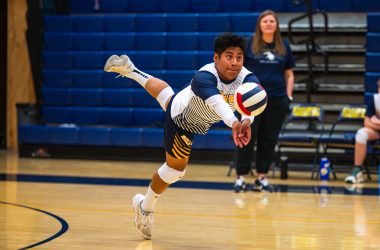“No person in the United States shall, on the basis of sex, be excluded from participation in, be denied the benefits of, or be subjected to discrimination under any education program or activity receiving Federal financial assistance.”
These 37 words were passed into law in 1972, changing the course of history for millions of girls and women around the country.
In the Southern Willamette Valley, the lasting legacy of the law weaves its way through the stories of four women who continue to represent and perpetuate its goals:
– Bev Smith, former University of Oregon women’s basketball player (1978- ‘82) and coach (2001- ‘09) and current executive director of Kidsports;
– PJ Rees, former UO volleyball, basketball, and softball player (1973-‘77);
– Jessica Crawford, Pleasant Hill High School volleyball coach and former New Mexico State volleyball player; and
– Keri Green, Springfield High School volleyball coach and former Bushnell volleyball player and golfer.
These women had their lives changed by Title IX in different ways and different eras. Title IX gave them something they didn’t have before: opportunity. While the law was initially drafted to prevent gender discrimination in education, perhaps the most notable change is how it influenced athletic and career opportunities for women.


Athletic, career opportunities
These increased opportunities led to something that is commonplace now: an increased level of competition and play. By giving girls a chance to compete, Title IX allows women’s sports to flourish in ways it never could before.
“I’ve seen the resources for every single program grow from zero, or having very meager beginnings, to where they are today, which is that women’s sports at Oregon do enjoy most of the same resources as the male athletes,” Rees said. “We have excellent coaching. We have travel budgets; we have equipment budgets; we have equipment sponsors; we’re in the Nike contract; we have better everything. Where we didn’t have resources in my time, they’re there now.
“It’s remarkable. It’s a world of change,” she said.
Smith agreed.
“The acceleration has taken place in the last 20 years because the media has started to promote women’s athletics,” she said. “And then coaching salaries started to rise, and that attracted more high-level coaches, too.”
Crawford and Green, who both coach at the high school level, have seen the increased participation trickle down as well.
“The level of play is impressive — even at some of the smaller-sized schools, which is what I’m familiar with,” Crawford said. “We may not have as big of a draw as some of the bigger schools, but at the same time, the knowledge is out there and the athletes are excited about it.”
“If anything, the exposure has been immense,” Green said. “We get these huge opportunities. It’s impressive to see the transformation of women’s sports in general.”
Leadership tools
The explosion of athletic opportunities bled into something else: the leadership skills and tools that sports provide, such as work ethic, teamwork, and communication.
“Title IX gave me a chance to discover my potential — not just as an athlete, but also as a student athlete,” Smith said. “It gave me experiences during college academically, athletically, and socially,” and also helped her develop and hone her leadership skills.
“Having those opportunities to build relationships, employability skills, and anything that you can think of surrounding those sports … I would not be anywhere close to the person I am today without having those opportunities available to me,” Green said.
Green and Crawford see the benefits they received from Title IX now firmly entrenched in the girls they coach.
“These young women are provided an opportunity to talk about leadership, respect, and how to develop a team environment and culture. And it’s not just on my team,” Crawford said. “There’s a big emphasis on that, and just having these young women hear those things, it’s going to catch on. That’s important.”
“I took this job because the work that we do at the high school matters,” Green said, crediting Title IX with giving student athletes the ability to compete, have a positive role model, and having someone to converse with. “The more that we have these opportunities for these young adults, we’re sending them out into the real world with real life skills, so these opportunities are immense.”
Academic possibilities
Title IX also gave many women a chance to attend college, something they may not have been able to afford otherwise.
“My sister had come down to finish off her education, and she’s a basketball player. So she played a year at Oregon, and then said, ‘You should come down and play. I think they’re going to be able to offer a scholarship because of Title IX,’” Smith said. “I was like, ‘that’s a pretty good idea,’ because it was hard for our parents to support two women going to college.”
It also gave Smith the chance to focus fully on her academics and athletics as opposed to working off her tuition.
She said that having a full-ride scholarship “had an immediate impact …Without that full ride, I wouldn’t have been able to come here because I couldn’t work in the summer as I was playing with our national team in Canada in summer. That was a big lift for me.”
Hardships and hurdles
While the success and impact of Title IX is well documented, all four of the women in this story said there is still work to be done.
That notion was evident from the very beginning, when the National Collegiate Athletic Association (NCAA) filed a lawsuit challenging the legality of Title IX in 1976. NCAA officials said that no athletic programs received direct federal funds, and thus the law was illegal.
That lawsuit was dismissed, however, and once it was dismissed the NCAA decided to take over women’s college athletics. Despite the NCAA taking over, there were still hurdles that women had to overcome.
“In my time at Oregon, when the team was on the road, I paid for most of my meals, and we used to sleep five women to a room in a hotel.” Rees said. “Each sport had its own uniforms for possibly the first time. Gymnasts had their own leotards, swimmers had their own suits but volleyball, basketball and softball shared a uniform season to season. And that stopped when I was at Oregon. Each team got their own uniforms.”
Some of those hardships that existed before no longer exist, but some still do, and new challenges have popped up.
“Progress has been made, and it’s just going to take time,” Smith said. “Title IX … really pushed open the door for women to say, ‘Hey, give us a chance, and you never know what will happen.’ Right now, almost 52% of students at universities are female, so the representation of them in athletics is not yet mirroring that.”
Green, who played college athletics more recently than the other three, sees the lack of opportunities still existing first hand — namely more coverage and more funding.
“A lot of women’s sports don’t get the same opportunities that some of the male sports do,” she said. “It is harder to fight for more of those opportunities, at least for the women’s side of sports. I also dealt with that in college where we were always given the short end of the stick.”
The short end of the stick was especially pointed during the 2021 NCAA women’s basketball tournament when the teams were given an inferior training facility for the event.
When the news broke, fans and athletes rallied in support of the teams.
“With Title IX, we have such a great opportunity to continue to expose inequities, much like Sedona Prince at the NCAA tournament in 2021,” Smith said, referring to a player who posted a video on social media showing the sad state of facilities. “You have an opportunity with social media to do constructive criticism that causes embarrassment for people like the NCAA to say, ‘Oh, yeah, we didn’t think anybody would notice.’ I’m hopeful that social media is a constructive tool for us to continue to fight the good fight and make available opportunities for women that are as equitable as they are for men.”
It’s been a long 50 years since Title IX passed, and though it’s clear there’s still work to do, the enduring legacy of the legislation is evident all over the country, and here in the Southern Willamette Valley. Women were given a chance to show their abilities on the court, the field, and in the classroom, and they’ve made the most of those chances.
“My mother grew up in a time where she didn’t have female sports teams to participate in,” Crawford said. “It was hard to understand when I was young, but as I’ve progressed, her history actually made more of an impact as I grew older and became an adult and was able to reflect about how amazing my opportunities were.”







